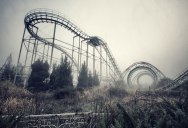A Tour of Japan Through the Lens of an Urban Explorer
by twistedsifter
Canadian photographer Chris Luckhardt (featured previously) travels the world in search of adventure and exploration. He specializes in documenting abandoned places and his travels through visual storytelling. His work has been featured on ABC News, The Weather Channel, MSN, The Daily Mail, Buzzfeed and many more. Chris has travelled throughout Japan six times, including a 2-month residency in Yokohama. As he explains:
“Japan is one of the most unique cultures in the world. Its homogeneous society, mountainous topography, and colourfully rich architecture and traditions offer a fertile ground for countlessly interesting photography opportunities. This series of photos is meant to highlight the beauty of Japan.”
The photo tour below is a perfect example of Chris’ visual storytelling. Follow along as we journey through Japan from high above Tokyo, to abandoned relics and famous monuments across the country. For more amazing photography, be sure to check out Chris at the links below.
Tokyo from Above
The sprawling metropolis of Tokyo, home to almost 36 million people, is best viewed from above. Tokyo Tower and Tokyo Skytree are the best places to see the extent of Tokyo’s urban reach.
Tokyo Skytree is the tallest tower in the world at 634 meters (Burj Khalifa in Dubai is the tallest building). The tower, opened in 2012, offers a spectacular view of Tokyo and the surrounding area. Mount Fuji can be seen in the distance on a clear day. Sunsets and night scenes from the tower are particularly awe inspiring.
Tokyo Tower, opened in 1958 and reaching 333 meters, also provides a stunning view of Tokyo. Due to the new popularity of Tokyo Skytree, this tower is often quicker to access for a wide view of the surrounding metropolis.
Hiroshima and Nagasaki
Hiroshima and Nagasaki are ground zero to two of the most devastating moments in human history. The atomic bomb that fell on Hiroshima detonated 580 meters above ground near the Hiroshima Prefectural Industrial Promotion Hall (later renamed as Genbaku Dome or A-Bomb Dome). Despite its proximity to the blast, the building’s reinforced concrete construction enabled it to become one of the few structures to remain (at least partially) standing. Approximately 75,000 people died instantly and virtually every other building was destroyed. The dome’s ruins have been preserved as a symbol of future peace.
Nagasaki was the site of the second wartime atomic bombing. Due to crosswinds, the bomb detonated off target in an area confined by a narrow valley, but the devastation was still catastrophic. An estimated 40,000-75,000 people were instantly killed. This site marks the detonation point of the bomb, which is now a beautiful park and memorial.
Fukushima
The second worst nuclear power plant accident in history occurred at the Fukushima Daiichi Nuclear Plant during the aftermath of the “Great East Japan Earthquake” of March 2011. Damage to the plant caused radiation to spread across Fukushima prefecture. Outside the current 30km exclusion zone, the constant fear of radiation exposure looms, but life must continue.
Wakamiya Ōji – Kamakura, Kanagawa
Japan is famous for its Cherry Blossoms (or Sakura) that primarily bloom in March and April. Large crowds turn out at parks, shrines and temples for viewing.
Itsukushima Island / Miyajima
Itsukushima Shrine is a shinto shrine, near Hiroshima, on the island of Itsukushima (popularly referred to as Miyajima). The shrine is famous for its torii gate, which appears to float during high tide. The shrine was off-limits to “commoners” throughout most of its history. Maintaining the island’s purity is considered important, meaning no deaths, births or burials are permitted.
The 5-story Pagoda on Miyajima was constructed in 1407 and is one of five similar structures in Japan. The Buddha of Medicine is enshrined inside.
Kawasaki, Kanagawa
Snow rarely falls in the Tokyo area. When there is snow, it usually melts quickly. In January 2013, the Tokyo area received its worst snowfall in decades; the metropolitan area was essentially shut down. This woman was one of the countless people struggling to walk through the snow covered streets of Kawasaki. Despite her pointed steel heeled boots she made it to her next shopping stop without falling down!
Hashima Island / Nara Dreamland
Haikyo (or “ruins”) is the term used in Japan to describe the art of urban exploration. People often think of Detroit and America’s rust belt when hearing the phrase urban exploration, but Japan also has a wide range of beautifully haunting abandoned places.
Hashima Island is one of the most famous abandoned places in the world. The island is located 15km off the coast of Nagasaki in the southern region of the country. The tiny island city, owned by Mitsubishi since 1880, was the center of a large coal mining operation. When coal use plummeted, Mitsubishi closed the mine and moved all of the residents and workers off of the island. This year marks the 40th anniversary of Hashima Island’s abandonment. The island has gained further notability for being featured as the villain’s lair in the James Bond film Skyfall.
Due to the popularity of Tokyo Disneyland and Universal Studios in Osaka, Japan has become the home of several abandoned theme parks. Nara Dreamland was a thriving copy of California’s Disneyland, but closed in 2006 due to declining attendance. Imagining the playful laughter of children that once occupied what is now a silent, misty theme park is a haunting experience.
Haikyo / Urban Exploration
Gifu prefecture, an industrial region of Japan, is home to several abandoned places. Two examples, a Buddhist temple and a wooden constructed school, demonstrate typical Japanese architecture of the early 20th century.
Deep underground in the Kanagawa region of Japan is a series of tunnels spanning 27km (according to conservative estimates). They were built during World War 2 as protection from United States air raids. The tunnel system was intricate; it was home to a 500 bed hospital, power plant, numerous warehouses and even a submarine factory!
Statues and Temples
Great Buddha is a 93 ton, 13.35m tall bronze statue located in Kamakura. The statue was constructed in 1252 and is one of the most popular tourist destinations in the region.
Another unique cultural and architectural element of Japan is its castles. Unlike it’s European counterparts, Japan’s castles were not built with defense as a strategy. The castle walls only contained the castle itself and not a castle town. They also had uniques stylings such as angled base walls, tiled roofs and were much smaller than European castles.
If you enjoyed this post, the Sifter
highly recommends:
Categories: ARCHITECTURE, BEST OF, HISTORY, STORIES, TRAVEL
Tags: · abandoned, interviews, japan, urban exploration









